Jeremy Umansky’s penchant for experimentation and envelope pushing, coupled with his academic and heuristic pursuits of food, have made him a pioneer of the culinary world
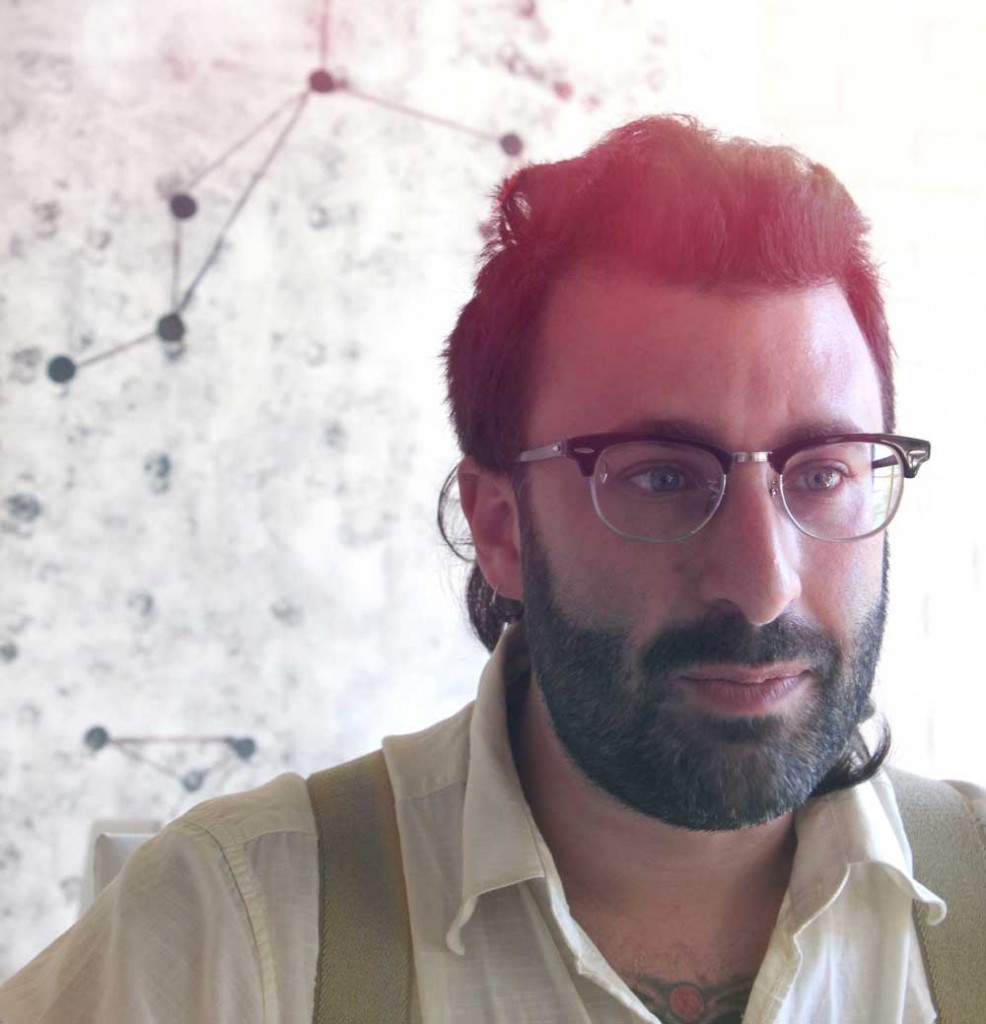
Story by Carlo Wolff
Photography by Michael C. Butz
To see and smell a piece of northern Italy in Cleveland, walk past the big wood-fired oven behind Trentina. To taste it, step inside to sample the chicken-liver ragù topped with crushed hickory nuts or the wild mushroom pizza topped with black trumpet mushrooms and four species of chanterelles. Those are but a few of the many menu items that star Jeremy Umansky’s unique blends of sauces, vinegars and foraged vegetables that set Trentina apart from other restaurants in Greater Cleveland’s astonishingly sophisticated and diverse food scene.
One afternoon in late July, Umansky’s larder – in the attic of a century-old brick building – was hot indeed. And it wasn’t just the temperature.
On its shelves were bottles of very good French wine maturing into very, very good vinegar; a ketchup more tawny than red; and a vinegar of garbanzo beans fermenting under a coating of koji, a Japanese mold Umansky and his boss, Chef Jonathon Sawyer, use to accelerate the curing of various foodstuffs, giving them a unique flavor and texture.
“I’ve never really looked at myself as an alchemist, a mad scientist,” says Umansky, who is both. “Everybody has an innate ability, whether it’s to communicate with people, or they can cook or paint a beautiful painting.”
If food were a verb, he’d be a “fooder.”
He serves up a taste from a jar of opaque brown liquid in his larder. The taste evokes the sea: briny, salty and bracing.
Don’t be scared to sample. Umansky isn’t. And Trentina, the refined and daring crown jewel of the Team Sawyer restaurant empire, is fearless itself. The University Circle establishment is a downsizing and modernization of the former Sergio’s. But where Sergio’s was Brazilian, Trentina draws inspiration from the cuisine of Trentino, the northern Italian province from which Sawyer’s wife Amelia and her family hail.
The tiny establishment (it seats 32 inside; an outdoor patio accommodates another 40), owned by the Sawyers, is a gourmet restaurant for the adventurous and discerning. It is the kind of place where Umansky, general manager there as well as larder master and wild food forager, Sawyer and corporate chef Brian Goodman push the culinary envelope beyond its limits, then snap it back into place.
“I think Jeremy, like me, requires constant stimulation and challenge,” Sawyer says in a telephone conversation from the Greenhouse Tavern, Team Sawyer’s flagship restaurant on Cleveland’s bustling East Fourth Street. “It’s been very easy for us to find things that continue to challenge us and keep us busy.”
Sawyer – 2015 James Beard Foundation Award for Best Chef Great Lakes winner– finds the inspiration and suggests techniques; then Umansky and Goodman, in their different capacities, “take it further. … They will take it and turn it into a megaphone.” Both have “a little bit to do with” every dish a Sawyer restaurant presents.
Umansky “easily” sees himself working for Sawyer for the next “five to 10 years, no problem.”
Umansky, who has lectured for the Slow Food organization, believes food shouldn’t come from contaminated land or contain artificial preservatives. He supports community-supported agriculture that reduces the links of the food chain, bringing consumer and producer into more direct contact.
“What right does the baker have to own and drive a BMW that the farmer doesn’t?” he asks.
“We should be co-consumers and co-producers every step along the way. It’s not two ends, it’s a circle,” he says of food, adding he wants “to see fair and equal access to foodstuffs worldwide. Free food for all. That’s essentially the way I look at it.”
Formative years
“I’ve never really looked at myself as an alchemist, a mad scientist. Everybody has an innate ability, whether it’s to communicate with people, or they can cook or paint a beautiful painting.” – Jeremy Umansky
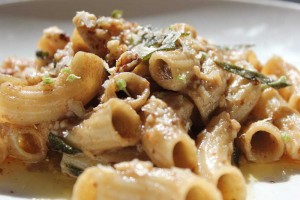
Trentina’s chicken liver ragù, with house-made rigatoni, sage and crushed hickory nuts.
“I was never taught I should be afraid of anything, especially when it came to food,” says Umansky, who grew up in Solon and now lives in Cleveland Heights with his wife, Alexandra La Valle, and their daughter, Emilia Morchella Louise.
As a kid, he wanted to be an archeologist. As a student, he took cultural anthropology courses at Cuyahoga Community College, but “decided I didn’t want to be locked into one thing specifically.”
It would be a while before Umansky settled on food as a career, though it seems to run in his family.
His grandmother, Phyllis Bookatz, was a kosher caterer at B’nai Jeshurun in Pepper Pike, “so I grew up around that a little before my bar mitzvah,” and his mother has always been a fantastic cook, he says. Besides, there was a “great blackberry patch” nearby; his mother would help pick out berries, dandelions, wood sorrel and other wild plants, and “we’d eat them.”
A forager was born.
There were hurdles, however. Umansky had an aversion to mashed potatoes, mousse, and pudding – a trait he knew wouldn’t help his career. Later in life, he increased his dosage of each in a weird form of self-immunization. (The man has always been a chemist at heart.)
“I literally would bring a plate of mashed potatoes or a bowl of pudding to my dorm, I’d take small, small bites and bigger and bigger ones until I became comfortable with those foods,” he says. To be the gastronome he wanted to be, “I could not have any aversions or taboos when it came to food.”
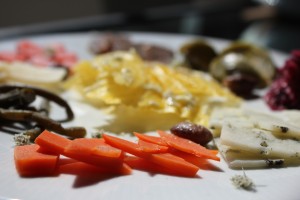
The Primo Assaggio (“little bites”) plate, which comes with an always-changing variety of vegetables and cheeses, is among the many offerings at Trentina.
He eventually dove into “an all-encompassing study of food, bigger than the food chain.” He wanted to know the best places to search out food, where the best wild mushrooms come from, whether you should eat them after a few dry days.
Umansky began to put it all together at the Culinary Institute of America in Hyde Park, N.Y., where his professor of gastronomy, Lani Raider, a “nice Jewish girl from the West Coast” who had relatives in Shaker Heights, became both colleague and friend.
Umansky never graduated from CIA, but he wrote an unusual paper for Raider: Asked where he saw his career in 10 years, he was the only student who didn’t write about owning a restaurant. His ambition: to be the first gastronome to obtain a fellowship with the National Geographic Foundation.
“I’ll get there eventually,” he says.
Umansky has clearly found his gustatory groove. In his teens and 20s, however, a different kind of chemistry ran him.
“My mother likes to use the word ‘mischievous’ but I was a very bad teenager,” he says, citing brushes with the police and suspensions from Solon High School. Calling himself a recovering heroin addict, he was busted for felony vandalism and agreed to go to rehab – at 19. The charge was reduced to a misdemeanor. Umansky celebrated 13 years of sobriety in April.
Throughout his drug use, he noted, he worked in the food business. “I can tell you of cooks that had sizzle platters with lines of cocaine on them,” he says.
In his early 20s, he said, he worked for his uncle Bart Bookatz at Berkowitz-Kumin-Bookatz Memorial Chapel. “Bart extended out to me hoping to help and keep me on the right path,” he said, but he realized then that his calling was food.
He left Cleveland for close to 10 years.
Returning home
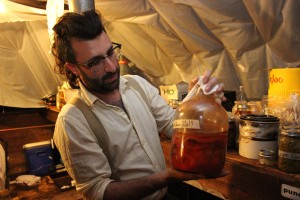
Umanksy discusses some of the items in Trentina’s larder, which include vinegars, sauces and preserves – some of which will hit plates and some of which is simply experimental.
Umansky spent most of that decade in the New York area, and in his last year there was chef de cuisine at Brooklyn Fish Camp, a seafood restaurant. He also founded an Internet start-up, Feast, along with two San Francisco entrepreneurs. The trio sold the online culinary school for home cooks last year, and Umansky was ready for a move.
He and his wife, who had worked at Whole Foods for five years, were looking at
San Francisco, Philadelphia, maybe Austin. But their attitude began to change after they came to Cleveland for Umansky’s best friend’s wedding.
The couple spent nearly a week here, and friends and family “poured quite a bit of honey in my wife’s ear,” he says. She loved Cleveland, so around New Year’s 2014, he gave notice and they decided to move.
Alexandra found work as a baker at Whole Foods in University Heights and Umansky, with help from friends Hallie Bram Kogelschatz and Eric Kogelschatz (he’s known her since he was 3), networked with the cream of Cleveland’s food establishment, including Sawyer. Armed with an unusual résumé and a culinary consulting business on the side, Umansky came to town that February for a “quick weekend” in which he spent a day working at Sawyer’s Greenhouse Tavern.
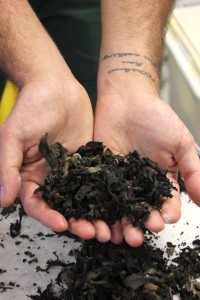
Umansky displays black trumpet mushrooms, a key Trentina ingredient.
Umansky told Sawyer he was a gastronome who specialized in wild mushrooms and fermentation, precisely the areas in which Sawyer aimed to expand. Sawyer said he’d been looking for just such a person for two years, and shortly hired Umansky. Since he joined Team Sawyer, Umansky has done line cooking at Trentina, started the foraging program and took over the team’s pasta program.
Now he’s general manager at Trentina, working four days a week, and able to spend time with his family, not to mention foraging and consulting. “It’s been a full-time job from the start,” Umansky says. “We’re not talking banker’s hours here.”
The relationship with Sawyer is “fantastic” and characterized by professional unselfishness, he says. “We look at food the same way, we look at the creative approach the same way, and as deep down the rabbit hole as the two of us go, when we come up with something new, you’ll never hear, ‘Look what I did.’”
One of the most unusual things they do is work with koji, that Japanese mold. Best known for its role in sake brewing and miso making, it made a name for itself in Trentina’s first fall menu, and Chef Sawyer suggests it might well reappear this fall.
Its vehicle? Scallops.
In its debut last fall, “koji-cured scallops turned out unbelievably, and still had that fresh kiss of the ocean,” Sawyer says. “I compared it to an apples-and-champagne smell, and it was an immediate success.
“Where we’re taking koji now, using it as an age accelerant, is very unique, not only to us but to the country,” says Sawyer. (The way in which Umansky has revolutionized koji as an age accelerant was the subject of his talk at TEDxCLE 2015.)
And Trentina’s use of koji speaks to the larger gastronomic mission, Umansky suggests. Gastronomy “binds us together,” says Umansky, and he’s there to push its limits. “In order to innovate, you have to be swift, you have to be creative,” he says. “I constantly have to impose limits on myself to understand what I do.
“For me, when I look at work and I look at my life, I’m doing it,” he says. “I mean, I named my daughter after a mushroom. The things I do at work, the fermentation, the curing of meat, the foraging, that’s what I do in my free time anyway. So work being work isn’t work for me. This is my life’s pursuit, this is my life’s love – outside of my wife and daughter.” js
Questioning kosher
By Carlo Wolff
“Some of the traditional laws behind kashrut no longer make sense when they’re dissected with science,” says Jeremy Umansky, Trentina’s general manager, noting that over the past 6,000 years, science has evolved, refrigeration is the norm, and sanitation and hygiene are commonplace.
Umansky, who writes extensively about food, believes it should be “good, clean and fair,” which is a tenet of the Slow Food movement. And while he feels that kashrut, the system of Jewish dietary law, has cultural importance for Jews, for those who adhere to the Islamic diet known as halal, and for Christians – in the “tree of monotheism, Judaism is the trunk,” he says – its rules are dated.
Dissecting human, animal and microbial physiology and understanding digestion, consumption and excretion has led him to this view, he says, even though at the time and place kashrut was formulated, the system of Jewish religious dietary practice made sense.
In ancient times, there was no concept of sanitation “outside of the physical appearance of dirt, and no concept of what hygiene was,” he says. Kashrut was “essentially designed to make sure that the physical appearance of something didn’t become contaminated,” and it became an edict enforced by the governing authorities of the time.
While he says he’s seen some theological and historical evidence that mixing milk and meat – which kashrut forbids – he questions it. “Would you bathe a kid in goat milk and cook it? (He is referencing Exodus 23:19). It just seems wrong. Why would you take a sheep and bathe it in sheep’s milk, in used milk, and cook it?”
Others, however, might say the kid and the milk – so to speak – pair perfectly in flavor, he says. When they were promulgated, some kashrut rules were “emotionally based and others were based on a physical contaminant that was actually there. But I feel that they’re very antiquated, that they’re dated.” js
